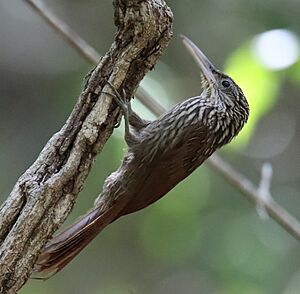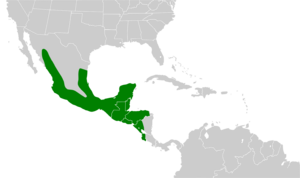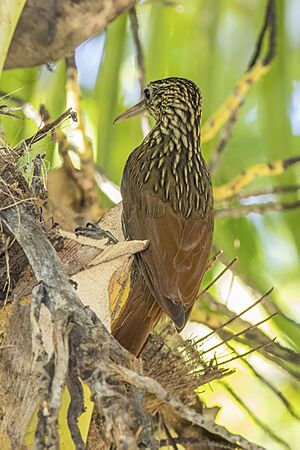Ivory-billed woodcreeper facts for kids
Quick facts for kids Ivory-billed woodcreeper |
|
|---|---|
 |
|
| Conservation status | |
| Scientific classification | |
| Genus: |
Xiphorhynchus
|
| Species: |
flavigaster
|
 |
|
The ivory-billed woodcreeper (scientific name: Xiphorhynchus flavigaster) is a type of bird that lives in forests. It belongs to the ovenbird family. You can find this bird in countries like Mexico, Belize, Guatemala, El Salvador, Honduras, Nicaragua, and Costa Rica.
Contents
About the Ivory-billed Woodcreeper
Different Types of Ivory-billed Woodcreepers
Just like there are different breeds of dogs, there are different types of ivory-billed woodcreepers. These are called subspecies. The ivory-billed woodcreeper has eight known subspecies. Each one is a little bit different.
Here are the names of these subspecies:
- X. f. tardus
- X. f. mentalis
- X. f. flavigaster
- X. f. saltuarius
- X. f. yucatanensis
- X. f. ascensor
- X. f. eburneirostris
- X. f. ultimus
What the Ivory-billed Woodcreeper Looks Like
This bird is about 20 to 26.5 centimeters (8 to 10.5 inches) long. That's about the length of a standard pencil. Male birds usually weigh between 40 and 62 grams (1.4 to 2.2 ounces). Females are a bit lighter, weighing 35 to 56 grams (1.2 to 2 ounces).
The ivory-billed woodcreeper has a long, strong bill that curves slightly downwards. Both male and female birds look very similar.
Colors and Patterns
The main type of ivory-billed woodcreeper, called X. f. flavigaster, has a face with fine light brown and dark streaks. It has a faint light brown stripe above its eye. Its head and neck are dark grayish-brown with long, light brown spots.
Its back and wing feathers are light grayish-brown to olive-brown. They have light brown streaks with dark edges. The bird's rump, tail, and wings are a rich reddish-brown color. Its throat is light brown with thin dark streaks. The upper part of its chest looks a bit scaly. The rest of its belly is light brownish with dark-edged light brown streaks.
The bird's eyes can be light reddish-brown or dark brown. Its bill is pale, often with a brownish or bluish base. Its legs and feet are yellowish-green, olive-gray, or brownish.
Young Birds
Young ivory-billed woodcreepers are a bit darker than adult birds. Their throat streaks are bolder, and the streaks on their back and chest are not as bright. Their bill is also brownish.
How Subspecies Differ
The other subspecies have slight differences in size and color:
- X. f. tardus is smaller and grayer.
- X. f. mentalis is smaller with a shorter bill.
- X. f. saltuarius is darker and browner. Its streaks are larger and bolder.
- X. f. yucatanensis is smaller and has a pale, plain throat.
- X. f. ascensor is the darkest subspecies. It has richer brown colors and wider streaks.
- X. f. eburneirostris is darker and browner. Its head and neck are very dark.
- X. f. ultimus is larger and darker than eburneirostris. It has a longer and heavier bill.
Even within the same subspecies, there can be some differences. Sometimes, birds from different subspecies can look very similar.
Where the Ivory-billed Woodcreeper Lives
The ivory-billed woodcreeper lives in different parts of Central America and Mexico. Each subspecies lives in a specific area:
- X. f. tardus is found in northwestern Mexico.
- X. f. mentalis lives on the Pacific side of Mexico.
- X. f. flavigaster is found in southwestern Mexico.
- X. f. saltuarius lives in northeastern Mexico.
- X. f. yucatanensis is found in the Yucatán Peninsula, Belize, and Guatemala.
- X. f. ascensor lives on the Caribbean side of southern Mexico.
- X. f. eburneirostris is found on the Caribbean side from Guatemala to Costa Rica. It also lives on the Pacific side from Mexico to Costa Rica.
- X. f. ultimus lives in the Nicoya Peninsula of Costa Rica.
Its Home Environment
This bird lives in many types of forests. It likes forests where trees lose their leaves every year. It also lives in evergreen forests, pine forests, and even swamps. You can find it inside forests or at their edges. It also lives in areas where trees have been replanted.
The ivory-billed woodcreeper prefers drier areas compared to many other woodcreepers. It usually lives from sea level up to about 1,500 meters (4,900 feet) high. In some places, it can be found as high as 2,900 meters (9,500 feet).
How the Ivory-billed Woodcreeper Behaves
Movement
Scientists believe the ivory-billed woodcreeper stays in the same area all year round. However, some birds might move to higher places after they have laid their eggs and raised their young.
Feeding Habits
The ivory-billed woodcreeper mainly eats arthropods, which are creatures like insects and spiders. It also eats other small animals like snails and small lizards.
This bird usually looks for food alone. Sometimes, it will forage in pairs. It often joins groups of different bird species that are feeding together. It also follows swarms of army ants. These ants stir up insects, making them easier for the bird to catch.
When not following ants, it usually searches for food in the middle and upper parts of trees. It climbs up tree trunks and along branches, often in a spiral pattern. It finds most of its food by poking into cracks in bark, or inside plants like bromeliads and epiphytes that grow on trees. Sometimes, it even peels off bark to find hidden prey.
Reproduction
The ivory-billed woodcreeper's breeding season seems to be from March to August. It builds its nest in a hole in a tree. Sometimes, it nests in gaps between the roots of Ficus trees. The bird lines its nest with wood chips, bark, or soft plant material.
A female bird usually lays two to three eggs. We don't know exactly how long the eggs take to hatch or how long it takes for the young birds to leave the nest. We also don't know many details about how the parents care for their chicks.
Sounds and Calls
The song of the ivory-billed woodcreeper in western Mexico sounds like loud, clear whistles. It starts low, gets louder, then goes down in pitch and slows down. It can sound like "t-t-t-ttttttttt-t-tewtewtew-tew-tew."
In northern Central America, its song is a fast trill that gets slightly lower in pitch at the end. In Costa Rica, it makes a loud, laughing, descending sound. Its other calls include sounds like "tchee-oo," "skweeú," "squirp," and "tyew-tyew-tyew."
Conservation Status
The IUCN (International Union for Conservation of Nature) has listed the ivory-billed woodcreeper as a species of "Least Concern." This means it is not currently in danger of disappearing. It lives across a very large area.
There are at least 500,000 adult birds, but this number is thought to be going down. However, no immediate threats to the species have been found. It is considered fairly common in most places where it lives. It is less common in the far north and "fairly uncommon" in Costa Rica.
This bird can live in both open and closed forest areas. It doesn't rely on true, untouched forests as much as some other woodcreepers. It seems to handle human activity quite well, as long as there are still some patches of forest left.



